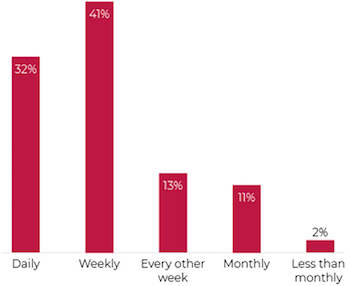Email marketing appears far from dead. Nearly 70 percent of businesses reported that they still rely on this marketing strategy, according to a recent survey about the email marketing habits of digital marketers released by business news site The Manifest.
The Manifest survey found that 69 percent of digital marketers admitted allocating time and money at their businesses for the purpose of email marketing.
Among businesses that invest in email marketing, the most popular topics behind this outreach involves product/company updates (69 percent), promotional emails (69 percent), newsletters, (68 percent) and event invitations (65 percent).

How often do businesses send marking emails? |
Typically, marketers said these commercial messages are dispatched either weekly (41 percent) or daily (32 percent).
Larger companies typically send the most emails, probably in reaction to their sizeable base. According to The Manifest survey, 37 percent of marketers stationed at businesses with more than 500 employees said their company dispatches marketing emails daily, as opposed to 21 percent of marketers working at companies staffing between 101 to 500 employees.
When asked to cite their primary objectives for engaging in email marketing, growing and retaining a company’s customer base (29 percent), followed by the prospect of increase engagement (22 percent), were the top reasons most marketers supplied.
Again, this variable revealed a disparity among company size: companies with more than 500 employees were more likely to use email marketing to increase engagement (25 percent), whereas smaller companies reported that they’re more likely to use email marketing to either grow and retain their customer base (34 percent) or to build brand awareness (17 percent).
The Manifest’s “The State of Email Marketing in 2018” report surveyed more than 500 digital marketers across the U.S. in March and April using brand intelligence research company Survata. All respondents are stationed at companies with more than 100 employees, and include managers (36 percent), associates (15 percent), C-level executives (13 percent), senior managers (12 percent) and directors (12 percent). About three-fourths (73 percent) of respondents work for B2C companies while 27 percent are employed with B2B companies.


 Abandon traditional content plans focused on a linear buyer progression and instead embrace a consumer journey where no matter which direction they travel, they get what they need, stressed marketing pro Ashley Faus during O'Dwyer's webinar Apr. 2.
Abandon traditional content plans focused on a linear buyer progression and instead embrace a consumer journey where no matter which direction they travel, they get what they need, stressed marketing pro Ashley Faus during O'Dwyer's webinar Apr. 2. Freelance marketers and the companies that hire them are both satisfied with the current work arrangements they have and anticipate the volume of freelance opportunities to increase in the future, according to new data on the growing freelance marketing economy.
Freelance marketers and the companies that hire them are both satisfied with the current work arrangements they have and anticipate the volume of freelance opportunities to increase in the future, according to new data on the growing freelance marketing economy. Home Depot's new attempt to occupy two market positions at once will require careful positioning strategy and execution to make it work.
Home Depot's new attempt to occupy two market positions at once will require careful positioning strategy and execution to make it work. Verizon snags Peloton Interactive chief marketing officer Leslie Berland as its new CMO, effective Jan. 9. Berland succeeds Diego Scotti, who left Verizon earlier this year.
Verizon snags Peloton Interactive chief marketing officer Leslie Berland as its new CMO, effective Jan. 9. Berland succeeds Diego Scotti, who left Verizon earlier this year.  Norm de Greve, who has been CMO at CVS Health since 2015, is taking the top marketing job at General Motors, effective July 31.
Norm de Greve, who has been CMO at CVS Health since 2015, is taking the top marketing job at General Motors, effective July 31.


 Have a comment? Send it to
Have a comment? Send it to 
No comments have been submitted for this story yet.